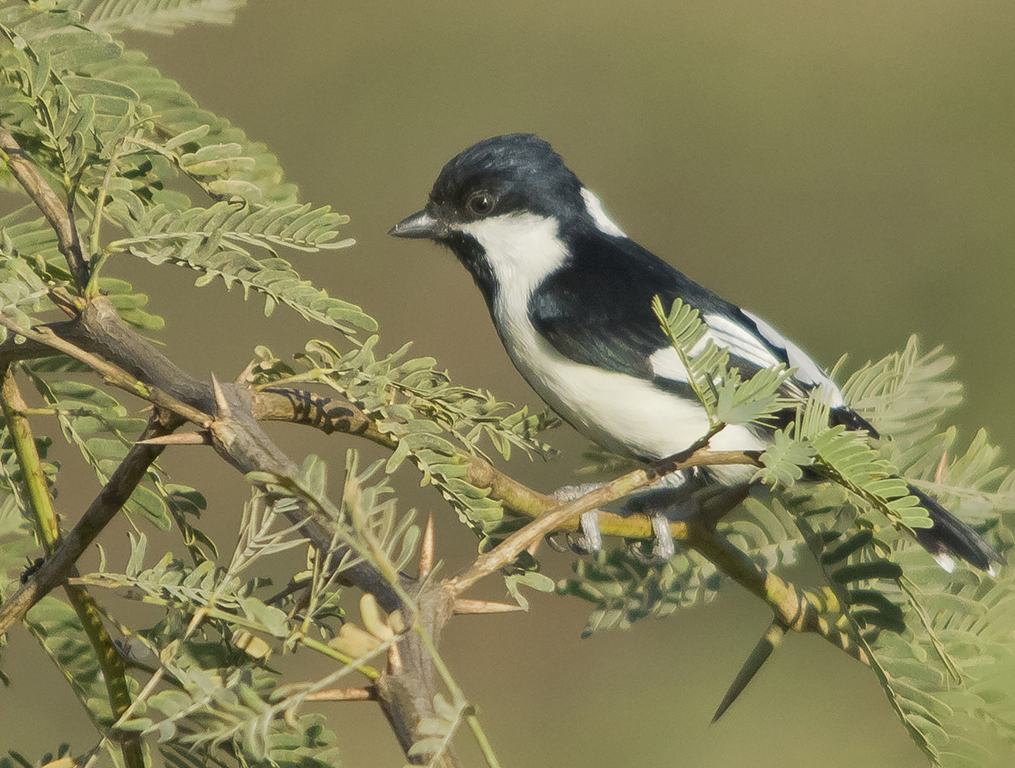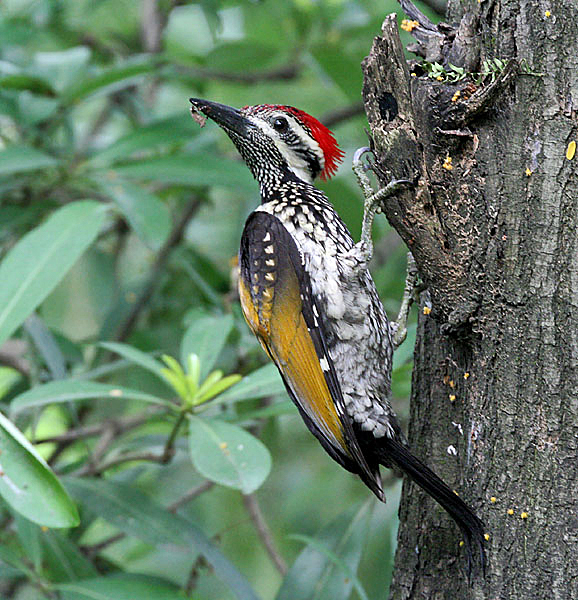|
Indian Yellow Tit (Parus Aplonotus)
The Indian black-lored tit, Indian tit, or Indian yellow tit (Grimmett ''et al.'', 2011) (''Machlolophus aplonotus'') is a passerine bird in the tit family Paridae. The yellow-cheeked tit is probably its closest relative, and both may be related to the yellow tit. These three tits almost certainly form a distinct lineage as evidenced by morphology, and mtDNA cytochrome ''b'' sequence analysis (Gill ''et al.'', 2005). The subgenus name ''Macholophus'' may apply for them. This species is a resident breeder on the Indian subcontinent. It is a common bird in open tropical forests, but does not occur in Sri Lanka. It is an active and agile feeder, taking insects and spiders from the canopy, and sometimes fruit. It is an easy tit to recognise in most of India, large in size at 13 cm, with a broad black line (broader in the male) down its otherwise yellow front. The large crest, neck, throat and head are black with yellow cheeks and supercilia. Upperparts are olive-green. It ha ... [...More Info...] [...Related Items...] OR: [Wikipedia] [Google] [Baidu] |
Edward Blyth
Edward Blyth (23 December 1810 – 27 December 1873) was an English zoologist who worked for most of his life in India as a curator of zoology at the Asiatic Society, Royal Asiatic Society of Bengal in Calcutta. He set about updating the museum's catalogues, publishing a ''Catalogue of the Birds of the Asiatic Society'' in 1849. He was prevented from doing much fieldwork himself, but received and described bird specimens from Allan Octavian Hume, A.O. Hume, Samuel Tickell, Robert Swinhoe among others. His ''Natural History of the Cranes'' was published posthumously in 1881. Early life and work On 23 December 1810, Blyth was born in London. His father, a cloth merchant, clothier, died in 1820 and his mother sent him to Dr. Fennell's school in Wimbledon, London, Wimbledon. He took an interest in reading, but was often to be found spending time in the woods nearby. Leaving school in 1825, he went to study chemistry, at the suggestion of Dr. Fennell, in London under Dr. Keating at S ... [...More Info...] [...Related Items...] OR: [Wikipedia] [Google] [Baidu] |
Sri Lanka
Sri Lanka, officially the Democratic Socialist Republic of Sri Lanka, also known historically as Ceylon, is an island country in South Asia. It lies in the Indian Ocean, southwest of the Bay of Bengal, separated from the Indian subcontinent, Indian peninsula by the Gulf of Mannar and the Palk Strait. It shares a maritime border with the Maldives in the southwest and India in the northwest. Sri Jayawardenepura Kotte is the legislative capital of Sri Lanka, while the largest city, Colombo, is the administrative and judicial capital which is the nation's political, financial and cultural centre. Kandy is the second-largest urban area and also the capital of the last native kingdom of Sri Lanka. The most spoken language Sinhala language, Sinhala, is spoken by the majority of the population (approximately 17 million). Tamil language, Tamil is also spoken by approximately five million people, making it the second most-spoken language in Sri Lanka. Sri Lanka has a population of appr ... [...More Info...] [...Related Items...] OR: [Wikipedia] [Google] [Baidu] |
Endemic Birds Of India
Endemism is the state of a species being found only in a single defined geographic location, such as an island, state, nation, country or other defined zone; organisms that are indigenous to a place are not endemic to it if they are also found elsewhere. For example, the Cape sugarbird is found exclusively in southwestern South Africa and is therefore said to be ''endemic'' to that particular part of the world. An endemic species can also be referred to as an ''endemism'' or, in scientific literature, as an ''endemite''. Similarly, many species found in the Western ghats of India are examples of endemism. Endemism is an important concept in conservation biology for measuring biodiversity in a particular place and evaluating the risk of extinction for species. Endemism is also of interest in evolutionary biology, because it provides clues about how changes in the environment cause species to undergo range shifts (potentially expanding their range into a larger area or becomi ... [...More Info...] [...Related Items...] OR: [Wikipedia] [Google] [Baidu] |
Helm Identification Guides
The ''Helm Identification Guides'' are a series of books that identify groups of bird Birds are a group of warm-blooded vertebrates constituting the class (biology), class Aves (), characterised by feathers, toothless beaked jaws, the Oviparity, laying of Eggshell, hard-shelled eggs, a high Metabolism, metabolic rate, a fou ...s. The series include two types of guides, those that are: * Taxonomic, dealing with a particular family of birds on a worldwide scale—most early Helm Guides were this type, as well as many more-recent ones, although some later books deal with identification of such groups on a regional scale only (e.g., ''The Gulls Guide,'' which covers only species in Europe, Asia, and North America) * Geographic, including all bird species in an area (e.g., ''The Birds of the West Indies'') Early volumes were sometimes published under the Croom Helm or Christopher Helm imprints. In addition, a parallel set of guides, very similar in design, was published b ... [...More Info...] [...Related Items...] OR: [Wikipedia] [Google] [Baidu] |
Auk (journal)
''Ornithology'', formerly ''The Auk'' and ''The Auk: Ornithological Advances'', is a peer-reviewed scientific journal and the official publication of the American Ornithological Society (AOS). It was established in 1884 and is published quarterly. The journal covers the anatomy, behavior, and distribution of birds. It was named for the great auk, the symbol of the AOS. In 2018, the American Ornithology Society announced a partnership with Oxford University Press Oxford University Press (OUP) is the publishing house of the University of Oxford. It is the largest university press in the world. Its first book was printed in Oxford in 1478, with the Press officially granted the legal right to print books ... to publish ''The Auk: Ornithological Advances'' and '' The Condor: Ornithological Applications''. In January 2021, the journal was renamed ''Ornithology'', with the stated goal of improving descriptiveness, thematic focus, and ease of citation of the journal title. The soc ... [...More Info...] [...Related Items...] OR: [Wikipedia] [Google] [Baidu] |
Clade
In biology, a clade (), also known as a Monophyly, monophyletic group or natural group, is a group of organisms that is composed of a common ancestor and all of its descendants. Clades are the fundamental unit of cladistics, a modern approach to taxonomy adopted by most biological fields. The common ancestor may be an individual, a population, or a species (extinct or Extant taxon, extant). Clades are nested, one in another, as each branch in turn splits into smaller branches. These splits reflect evolutionary history as populations diverged and evolved independently. Clades are termed ''monophyletic'' (Greek: "one clan") groups. Over the last few decades, the cladistic approach has revolutionized biological classification and revealed surprising evolutionary relationships among organisms. Increasingly, taxonomists try to avoid naming Taxon, taxa that are not clades; that is, taxa that are not Monophyly, monophyletic. Some of the relationships between organisms that the molecul ... [...More Info...] [...Related Items...] OR: [Wikipedia] [Google] [Baidu] |
Molecular Phylogenetic
Molecular phylogenetics () is the branch of phylogeny that analyzes genetic, hereditary molecular differences, predominantly in DNA sequences, to gain information on an organism's evolutionary relationships. From these analyses, it is possible to determine the processes by which diversity among species has been achieved. The result of a molecular phylogenetic analysis is expressed in a phylogenetic tree. Molecular phylogenetics is one aspect of molecular systematics, a broader term that also includes the use of molecular data in taxonomy and biogeography. Molecular phylogenetics and molecular evolution correlate. Molecular evolution is the process of selective changes (mutations) at a molecular level (genes, proteins, etc.) throughout various branches in the tree of life (evolution). Molecular phylogenetics makes inferences of the evolutionary relationships that arise due to molecular evolution and results in the construction of a phylogenetic tree. History The theoretical fra ... [...More Info...] [...Related Items...] OR: [Wikipedia] [Google] [Baidu] |
Machlolophus
''Machlolophus'' is a genus of birds in the tit (bird), tit family. The species were formerly placed with many others in the genus ''Parus'' but were moved to ''Machlolophus'' based on a molecular phylogenetic analysis published in 2013 that showed that the members formed a distinct clade. The name ''Machlolophus'' was introduced by the German ornithologist Jean Cabanis in 1850. The word is derived from the classical Greek ''makhlos'' meaning luxuriant, and ''lophos'' meaning crest. The following species, all from Asia, have been placed in the genus: References Machlolophus, Bird genera Birds of Asia, {{Paridae-stub ... [...More Info...] [...Related Items...] OR: [Wikipedia] [Google] [Baidu] |
Parus
''Parus'' is a genus of Old World birds in the tit family Paridae. It was formerly a large genus containing most of the 50 odd species in the family Paridae. The genus was split into several resurrected genera following the publication of a detailed molecular phylogenetic analysis in 2013. The genus name, ''Parus'', is the Latin word for "tit". Taxonomy The genus ''Parus'' was introduced in 1758 by the Swedish naturalist Carl Linnaeus in the tenth edition of his ''Systema Naturae''. The genus name is Latin for "tit". Of the 12 species included in the genus by Linnaeus, the type species was designated as the great tit (''Parus major'') by George Robert Gray in 1840. Species The genus now contains the following three species: Fossil record *'' Parus robustus'' (Pliocene of Csarnota, Hungary) Kessler, E. 2013. Neogene songbirds (Aves, Passeriformes) from Hungary. – Hantkeniana, Budapest, 2013, 8: 37-149. *'' Parus parvulus'' (Pliocene of Csarnota, Hungary) *'' Par ... [...More Info...] [...Related Items...] OR: [Wikipedia] [Google] [Baidu] |
Megalaimidae
Megalaimidae, the Asian barbets, are a family of birds, comprising two genera with 35 species native to the forests of the Indomalayan realm from Tibet to Indonesia. They were once clubbed with all barbets in the family Capitonidae but the Old World species have been found to be distinctive and are considered, along with the Lybiidae and Ramphastidae, as sister groups. Taxonomy In the past the species were placed in three genera, ''Caloramphus'', ''Megalaima'' and ''Psilopogon'', but studies show that ''Psilopogon'' to be nested within the clade of ''Megalaima''. Since members of this clade are better treated under a single genus, they have been moved to the genus ''Psilopogon'' which was described and erected earlier than ''Megalaima'' and is therefore chosen on the basis of taxonomic priority principles. Nearly all members of the family are now in the genus ''Psilopogon'', with the exception of those in ''Caloramphus'', which are thought to have Genetic divergence, genetically d ... [...More Info...] [...Related Items...] OR: [Wikipedia] [Google] [Baidu] |
Woodpecker
Woodpeckers are part of the bird family (biology), family Picidae, which also includes the piculets, wrynecks and sapsuckers. Members of this family are found worldwide, except for Australia, New Guinea, New Zealand, Madagascar and the extreme polar regions. Most species live in forests or woodland habitats, although a few species are known that live in treeless areas, such as rocky hillsides and deserts, and the Gila woodpecker specializes in exploiting cacti. Members of this family are chiefly known for their characteristic behaviour. They mostly forage for insect prey on the trunks and branches of trees, and often communicate by drumming with their beaks, producing a reverberatory sound that can be heard at some distance. Some species vary their diet with fruits, birds' eggs, small animals, tree sap, human scraps, and carrion. They usually nest and roost in holes that they excavate in tree trunks, and their abandoned holes are of importance to other cavity-nesting birds. They ... [...More Info...] [...Related Items...] OR: [Wikipedia] [Google] [Baidu] |
Nuthatch
The nuthatches () constitute a genus, ''Sitta'', of small passerine birds belonging to the family Sittidae. Characterised by large heads, short tails, and powerful bills and feet, nuthatches advertise their territory using loud, simple songs. Most species exhibit grey or bluish upper parts and a black eye stripe. Most nuthatches breed in the temperate or montane woodlands of the Northern Hemisphere, although two species have adapted to rocky habitats in the warmer and drier regions of Eurasia. However, the greatest diversity is in Southern Asia, and similarities between the species have made it difficult to identify distinct species. All members of this genus nest in holes or crevices. Most species are non-migratory and live in their habitat year-round, although the North American red-breasted nuthatch migrates to warmer regions during the winter. A few nuthatch species have restricted ranges and face threats from deforestation. Nuthatches are omnivorous, eating mostly insec ... [...More Info...] [...Related Items...] OR: [Wikipedia] [Google] [Baidu] |






